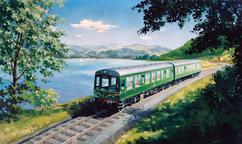

The Liverpool and Manchester Railway
Wood engraving. Sketch of the Carriages on the Liverpool and Manchester Railway. Drawn by Henry Austen, March 1832. Printed by George Smith. Published by Thomas Taylor, Castle Street.
This 1832 engraving depicts two trains of carriages on the Liverpool and Manchester Railway. The upper train is pulled by the steam locomotive Planet, while the lower train is pulled by Venus. When the Liverpool and Manchester Railway opened in 1830 it was the first steam-powered inter-city railway in the world, running for 50km between the two cities. The railway’s chief engineer was George Stephenson (1781-1848).
As shown in this print, the railway transported not only passengers but also livestock and goods. The second-class carriage (labelled number 3 in the top row) notably has a roof. This was a feature that was only fitted in August 1831, after complaints that falling cinders burned passengers’ clothing.
Before 1830, travelling between Manchester and Liverpool meant either a slow trip by canal or a dangerous one by road. Once the railway opened, people could now travel quickly and safely between the two cities. This massive change had a large cultural impact – the railway was commemorated not only in prints like this one but also in the illustrated news, as well as on mugs, bowls, and medals.
It has been estimated that no fewer than 2,000 prints of railway subjects were produced during the years 1830 to the late 1840s, and scarcely a line opened without at least one view of its engineering accomplishments being published. It is difficult for us today to understand the emotional as well as financial commitment to railways during these early years. The railway was often seen as a slowly spreading symbol of change and progress towards a better world.




